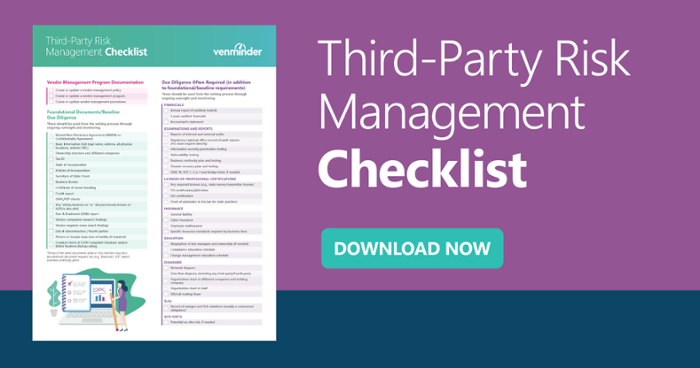In the risk management industry, we throw a lot of terms around. We volley labels like third-party risk management, vendor management, vendor risk management, due diligence, vendor owners, vendor managers and dozens of acronyms and shorthand for many similar, yet distinct, concepts so often that it's quite easy to lose the thread of what we’re actually talking about.
In a nutshell, vendor management is:
The process of fully identifying all the significant vendors that aid in the delivery of a product or service to your organization or to your customers on behalf of your organization. It involves managing, assessing and taking steps to mitigate risks you uncover with those vendors.
What Does Vendor Management Help Accomplish?
Risk is a word that’s almost always tossed around when we talk about this process. We talk about risk management because that’s what we’re doing, but the truth is, risk management is only one component of what vendor management actually accomplishes. As a whole, vendor management is what keeps your organization on track and organized when it comes to the support and integration of vendor relationships.
Here are a few of the most important facets of vendor management and areas it helps in:
- Selecting vendors. A vendor management program helps your organization query, compile, analyze and ultimately select the right vendors for the product or service your team needs. This is very important. Not vetting your vendors properly can be very costly in a variety of ways and could put your operations, your reputation, and ultimately your wallet, at risk.
- Keeping your vendors organized. One of the biggest perks to vendor management is having a system for all the many, many moving parts of a third-party relationship: from contracts, reports and due diligence documentation (business continuity plans, disaster recovery plans, cybersecurity findings, etc.) service level metrics and more. Organization is crucial to ensuring you know exactly where your organization relies on vendor relationships, and where each vendor stands in the areas that could affect your operations. It’s important to be able to quickly answer important questions such as, “Is my vendor sticking to their security requirements?” or “which vendors have access to sensitive customer data?”
- Creating a vendor strategy. The stronger and more mature your vendor management program becomes, the more capable it is of working for you. What do we mean by that exactly? The more work you put in up front to both organize and streamline your vendor profiles, the better able you’ll be to strategically use the information it provides to create a plan for your organization. For example, a comprehensive inventory of vendors can shed insight into duplicated services, showing you ways to cut costs and streamline processes. You may also find an exorbitant amount of money is spent on outsourcing a function that could be more cost effective to hire in-house.
- Mitigating vendor risk. As we mentioned above, vendor management is also a huge factor when it comes to managing vendor risk. The selection, organization and strategic insights vendor management provides also helps create a tailored, risk “blueprint” for your vendors so you can avoid troublesome vendors altogether, stay abreast of trends, pinpoint service gaps and address areas of concern before they become critical.
Your First Step in Vendor Management
Now that you understand more about what vendor management is, let’s briefly touch on your first big step to get started. It’s identifying your vendors. It’s incredibly important that you do your research and determine every company involved in providing a product or service to your organization. Seems like it should be easy, right? It’s actually a multi-step process that requires you to review the scope of your vendor management program, check in with accounts payable for a vendor list and prioritize vendors who need increased oversight.
Truthfully, vendor management is equal parts science and an art. Yes, you need to have processes in place and you need to be strategic, but you also need be ready to use some creativity when needed to protect your organization and keep the process moving. Vendor management encompasses both of these qualities, which makes it a challenging, yet a rewarding foundation for organizational success.
Now that you understand what vendor management is, make sure you also understand what you need to accomplish. Download the checklist.



















